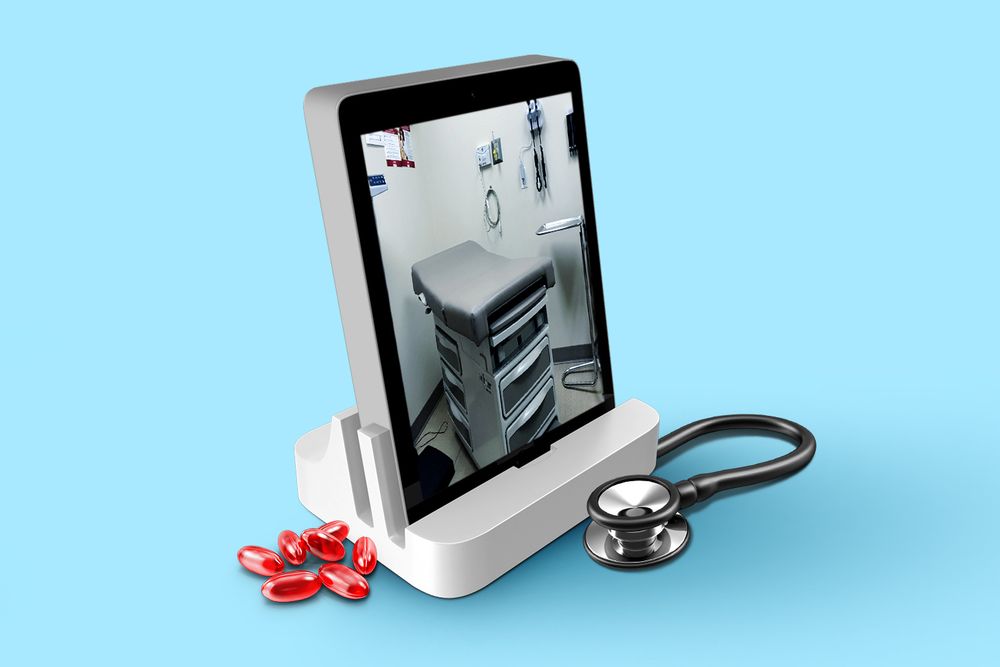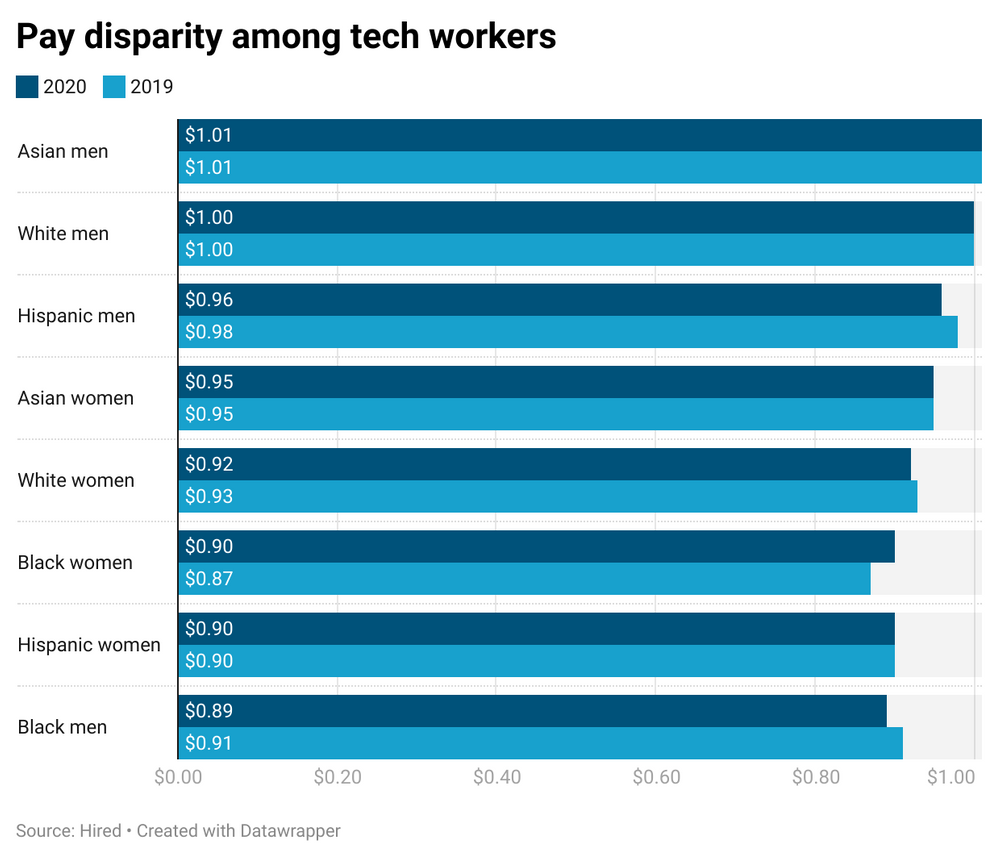|
What’s up? On the Eastern Seaboard, where most of Emerging Tech Brew lives, it felt like summer this past weekend. Meanwhile, it was rainy and gross in Ryan’s home base of Austin, TX. Finally, revenge for all those Zoom calls he was taking outdoors in March…
In today’s edition:
 Healthcare AI Healthcare AI
 Snap AR Snap AR
 Pay gaps Pay gaps
—Ryan Duffy, Hayden Field, Dan McCarthy
|
|

Francis Scialabba
|
One reason health care is so costly in the US: testing. It’s a circular problem, since more tests = more diagnoses...but also higher costs for patients.
Thanks to a new algorithm developed by the Mayo Clinic, AI may be able to help with both—at least with one high-stakes heart condition. The news comes from one of the first large-scale trials to demonstrate AI's effectiveness in a real-life healthcare setting.
Gimme context
For several years, the Mayo Clinic has been working on an algorithm to diagnose “low ejection fraction”—a key indicator of heart failure, which is the leading cause of hospitalization for people aged 65+.
- Ejection fraction is the percentage of blood that your heart pumps out each time it contracts. 50% to 75% is the norm; anything under 40% is considered dangerously low.
More context: Your heart’s electrical signals power your heartbeats. An electrocardiogram (ECG or EKG) uses electrodes to record those signals and translate them into waves on a chart. Doctors study those waves to find the rhythm of your heartbeat, and to gauge the probability of certain heart conditions.
Where AI comes in
Clinicians can rarely flag heart failure risk from EKG data alone. AI is much better at it.
- “The human clinician, if they look at this image, they will not [be able to] tell whether the patients have heart failure or not,” Dr. Xiaoxi Yao, a health outcomes researcher at the Mayo Clinic and the study’s lead author, told us. “The AI sees something we clinicians cannot see….It’s quite new.”
And since EKGs are common, accessible, and low-cost (about $50), they’re a top-tier candidate for AI enhancement. Ideally, AI can “improve the early diagnosis without increasing costs,” Yao said.
Trial and success: During the randomized clinical trial (RCT), more than 20,000 patients had their EKGs analyzed by AI, and results were promising. “For every 1,000 patients screened, the AI screening yielded five new diagnoses of low ejection fraction over usual care,” Yao said in the Mayo Clinic’s release.
By spotting nuances invisible to doctors, the algorithm can flag anomalies in a patient early on, gauge the likelihood of early-stage heart failure, and, from there, recommend whether they should undergo additional (and often expensive) testing—like a $1,000-to-$2,000 echocardiogram, which uses ultrasound waves.
Big picture: “If we can identify the early-stage heart failure earlier, before patients become very symptomatic, then we can initiate prevention early to prevent the mortality and the progression of the disease,” Yao said. “Our AI is trying to do something that ECG in the past could not do.”—HF
|
|

Francis Scialabba
|
You may think of Snapchat as a social media company, but Snap considers itself a camera company. Within the next decade, that may be an augmented reality company. (Also, a commerce company.) ¿Por qué no los dos?
Last week, Snap revealed its fourth-gen Spectacles. They’ll have a display component, making them true AR glasses for the first time, along with four built-in mics, two stereo speakers, and a touchpad.
- The company also confirmed that it would buy WaveOptics, its UK-based AR display supplier, for $500 million, The Verge reported Friday.
- On the software side, Snap is working its way toward operating system-level AR, with Lens, Scan, and virtual try-on tools.
Seeing 20/20
CEO Evan Spiegel seems pretty sure that the technology will be an important part of the next wave of computing. Still, Snap knows AR isn’t ready for a mass-market debut. Case in point: Spectacles V4 only have a half-hour of battery life. Instead, they will be distributed to thousands of developers and Lens creators who apply to tinker with them.
Zoom out: Microsoft sells HoloLens AR headsets, but they’re still priced and positioned as an early adopter device. Facebook, which owns VR leader Oculus, is just starting to roll out a research-oriented AR prototype. Meanwhile, Apple is developing a device it could reveal as early as next year.—RD
|
|
SPONSORED BY ORACLE NETSUITE
|

|
What makes a great CFO? It’s kinda like asking what makes a great hot dog. Each one is unique, but the best ones have some key traits in common.
According to this ebook from Jack McCullough, a recognized thought leader and founder of the CFO Leadership Council, great CFOs have several shared superpowers, including:
- The right combination of cheddar, shallots, and mustard
-
Building an elite team that aligns with your goals
-
Knowing how to network with boards and other CFOs
-
Ability to perform cross-functionally while managing regular tasks
Basically, rockstar CFOs understand the mission, goals, and objectives of the organizations they lead.
But there’s more to it.
Find out what distinguishes a CFOutstanding from a CFOrdinary here.
|
|

Dan McCarthy
|
Last week, Hired, a tech-focused jobs marketplace, released its fifth annual report on pay disparity in tech across the US, the UK, and Canada.
High-level takeaway: Although the gap(s) have narrowed, the general story stays the same. For the same job, women in tech are paid less than men, and Black and Hispanic people less than white and Asian people. A rundown of key data points...
- 59% of the time, men were offered higher pay than women for the same job at the same company, down from 65% in 2019.
- On average, women in tech were offered 2.5% less than men for the same roles, down from 4.4% the prior year.
- Overall, the gap was widest for Black men, who made $0.89 on the dollar compared with white men, and then Black and Hispanic women, who each made $0.90.
Zoom out: Hired’s data focuses on racial and gender pay disparities for the same job title. But tech companies still have a long way to go in making those roles (particularly high-paying technical roles) accessible to women, Black, and Hispanic people in the first place.
|
|

Virgin Orbit/Getty Images
|
Stat: According to a survey of 44 tech startups that SPAC’d between January 2020–April 2021, their average share price had fallen 12.6% by mid-May.
Quote: “We will not cede truck leadership.”—Darren Palmer, Ford’s head of battery EVs, said to Ryan in reference to Ford’s new fully electric F-150
Read: Facebook continued to recommend anti-vax groups months after saying it would ban them.
Electrify your IT: When you book a meeting with Electric and upgrade your IT, not only do you beat the competition, you get a free pair of Beats Solo3 Wireless headphones. Chat with Electric today.*
*This is sponsored advertising content
|
|
SPONSORED BY MIT SCHOOL OF ARCHITECTURE + PLANNING AND ESME LEARNING
|

|
You MIGHT get free tuition, but you WILL transform the health space. MIT’s Health Ventures course is for all you smarty-pantses looking to transform the business of health with radical new tech. Not only will you study under faculty director Professor Rosalind Picard—a prominent health tech thought leader—but you’ll have MIT’s resources at your fingertips and build yourself a powerful professional network. You can enter to win free tuition here.
|
|
-
DeepMind is the advanced AI research lab Google acquired in 2014. It’s sought—and failed—to maintain independence from its parent company, the WSJ reports.
-
Pony.ai is now the eighth company permitted to test driverless cars on California streets.
-
Researchers developed a robotic arm with an artificial sense of touch.
-
Netflix is looking to break into gaming.
-
Nick Clegg, Facebook’s VP of global affairs, writes in CNBC that there are four areas of internet regulation with bipartisan support: Section 230 reform, protections against foreign interference, federal privacy legislation, and data portability requirements.
-
Samsung is expanding its lineup of all-in-one Smart Monitors.
|
|
THREE THINGS WE’RE WATCHING
|
|
Today: The Epic v. Apple legal battle’s final day of proceedings. Today, the court will hear closing arguments. Although the judge’s final ruling could technically come this week, we’re not holding our breath.
Wednesday. Nvidia reports earnings. The company has had quite a year, overtaking Intel as the largest US chipmaker by market cap. We’re eager to hear 1) what Nvidia execs have to say about the ongoing chip shortage, and 2) the latest on Nvidia’s battle to keep crypto miners from hoarding its gaming-specific GPUs.
Friday: Signing off early and settling into our three-day weekend.
|
|
|
Bigwig gigs don’t grow on trees. If you’re a high-level exec, looking for job opportunities in the usual places probably won’t cut it. That’s why we partnered with ExecThread, the platform with confidential jobs for people who’ve graduated beyond job boards. Today’s featured postings:
Check out all the super cool jobs here.
|
|
|
Catch up on the top Emerging Tech Brew stories from the past few editions:
|
|
|
Written by
Dan McCarthy, Hayden Field, and Ryan Duffy
Was this email forwarded to you? Sign up here.
|
ADVERTISE // CAREERS // SHOP // FAQ
Update your email preferences or unsubscribe here.
View our privacy policy here.
Copyright © 2021 Morning Brew. All rights reserved.
22 W 19th St, 8th Floor, New York, NY 10011
|
|










